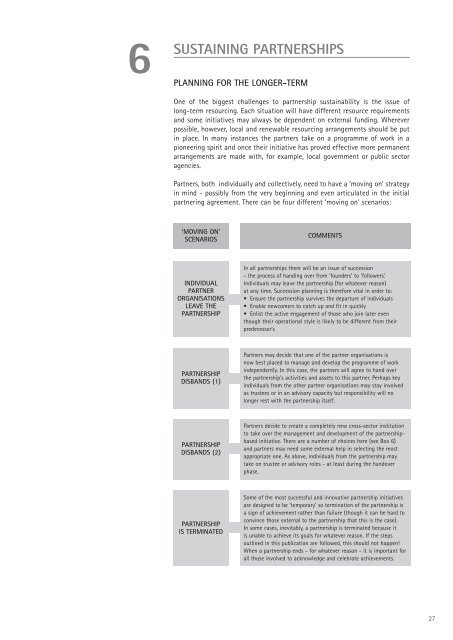Partnering
The Partnering Toolbook - Energize, Inc.
The Partnering Toolbook - Energize, Inc.
- No tags were found...
Create successful ePaper yourself
Turn your PDF publications into a flip-book with our unique Google optimized e-Paper software.
6<br />
SUSTAINING PARTNERSHIPS<br />
PLANNING FOR THE LONGER-TERM<br />
One of the biggest challenges to partnership sustainability is the issue of<br />
long-term resourcing. Each situation will have different resource requirements<br />
and some initiatives may always be dependent on external funding. Wherever<br />
possible, however, local and renewable resourcing arrangements should be put<br />
in place. In many instances the partners take on a programme of work in a<br />
pioneering spirit and once their initiative has proved effective more permanent<br />
arrangements are made with, for example, local government or public sector<br />
agencies.<br />
Partners, both individually and collectively, need to have a ‘moving on’ strategy<br />
in mind - possibly from the very beginning and even articulated in the initial<br />
partnering agreement. There can be four different ‘moving on’ scenarios:<br />
‘MOVING ON’<br />
SCENARIOS<br />
COMMENTS<br />
INDIVIDUAL<br />
PARTNER<br />
ORGANISATIONS<br />
LEAVE THE<br />
PARTNERSHIP<br />
In all partnerships there will be an issue of succession<br />
- the process of handing over from ‘founders’ to ‘followers’.<br />
Individuals may leave the partnership (for whatever reason)<br />
at any time. Succession planning is therefore vital in order to:<br />
• Ensure the partnership survives the departure of individuals<br />
• Enable newcomers to catch up and fit in quickly<br />
• Enlist the active engagement of those who join later even<br />
though their operational style is likely to be different from their<br />
predecessor’s<br />
PARTNERSHIP<br />
DISBANDS (1)<br />
Partners may decide that one of the partner organisations is<br />
now best placed to manage and develop the programme of work<br />
independently. In this case, the partners will agree to hand over<br />
the partnership’s activities and assets to this partner. Perhaps key<br />
individuals from the other partner organisations may stay involved<br />
as trustees or in an advisory capacity but responsibility will no<br />
longer rest with the partnership itself.<br />
PARTNERSHIP<br />
DISBANDS (2)<br />
Partners decide to create a completely new cross-sector institution<br />
to take over the management and development of the partnershipbased<br />
initiative. There are a number of choices here (see Box 6)<br />
and partners may need some external help in selecting the most<br />
appropriate one. As above, individuals from the partnership may<br />
take on trustee or advisory roles - at least during the handover<br />
phase.<br />
PARTNERSHIP<br />
IS TERMINATED<br />
Some of the most successful and innovative partnership initiatives<br />
are designed to be ‘temporary’ so termination of the partnership is<br />
a sign of achievement rather than failure (though it can be hard to<br />
convince those external to the partnership that this is the case).<br />
In some cases, inevitably, a partnership is terminated because it<br />
is unable to achieve its goals for whatever reason. If the steps<br />
outlined in this publication are followed, this should not happen!<br />
When a partnership ends - for whatever reason - it is important for<br />
all those involved to acknowledge and celebrate achievements.<br />
27


